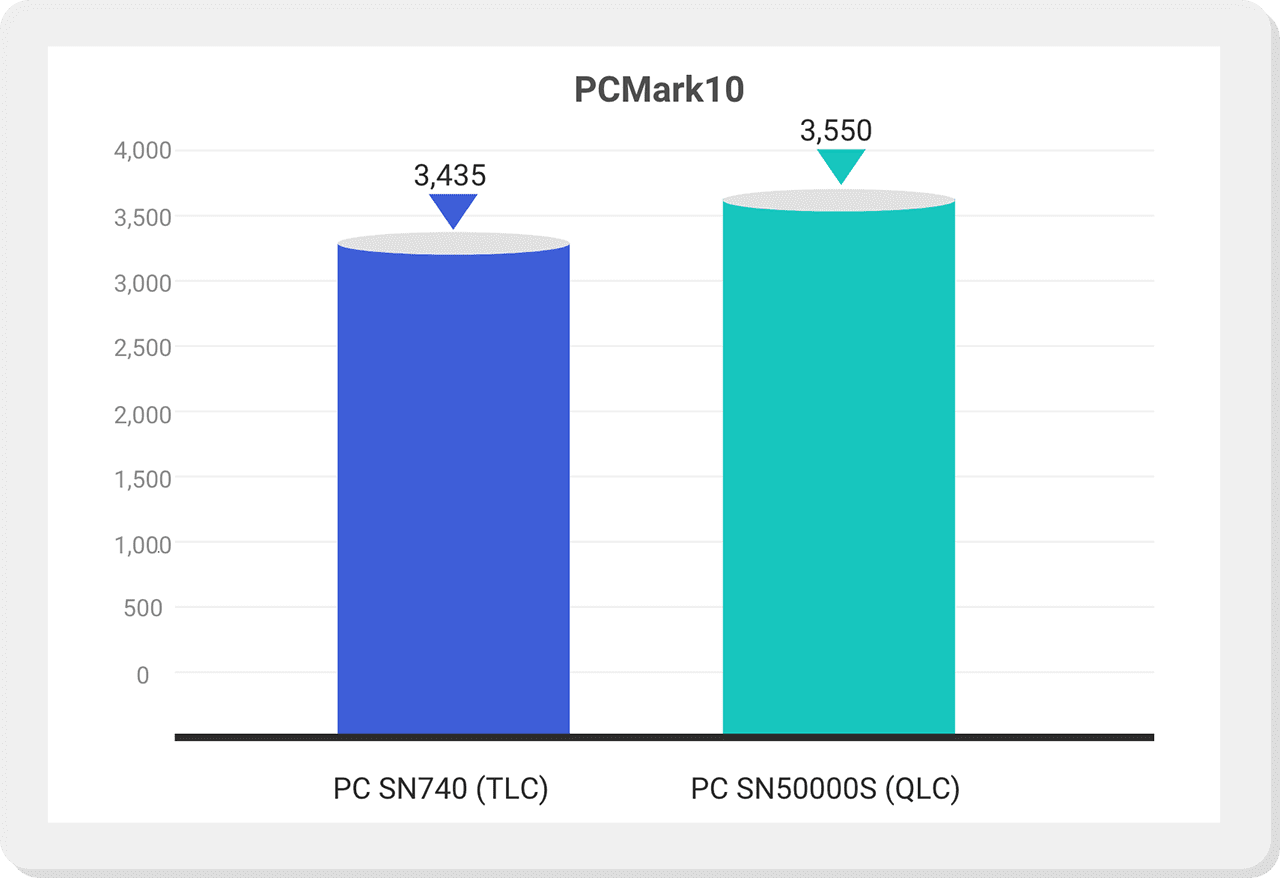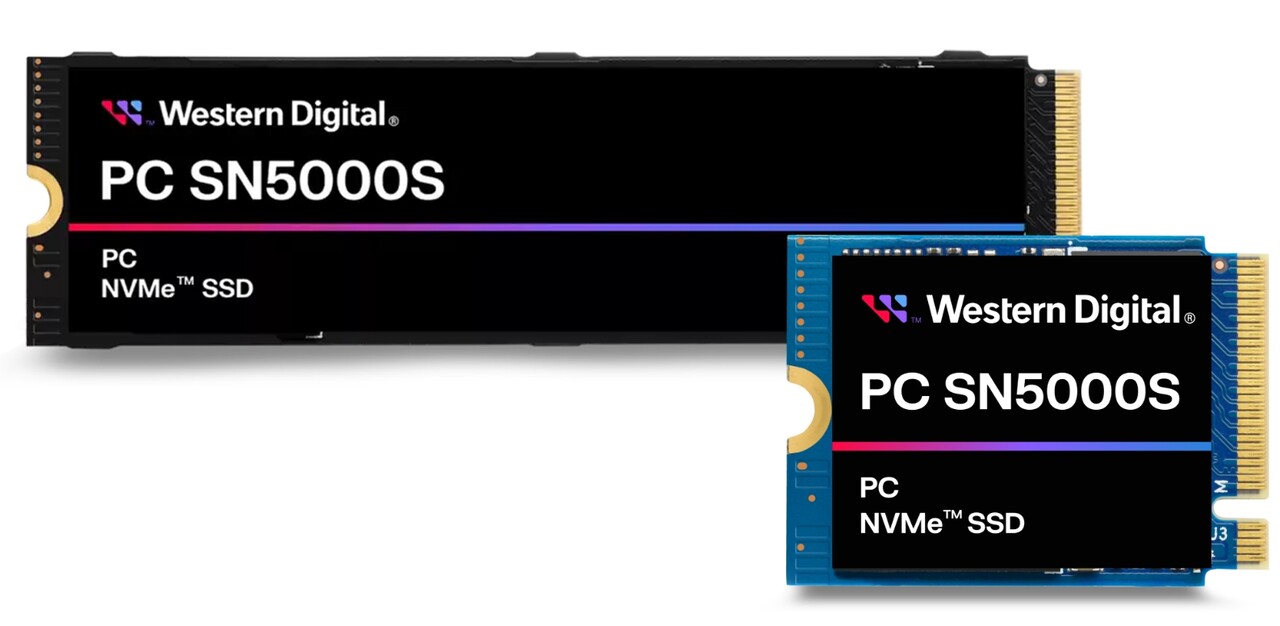QLC χωρίς συμβιβασμούς
Εξερευνήστε πώς η Western Digital Innovation™ παρέχει βελτιωμένη πυκνότητα bit χωρίς να θυσιάζεται η απόδοση σε όλες τις μονάδες QLC, όπως η νέα μονάδα Western Digital PC SN5000S NVMe™ SSD.
Μάθετε περισσότερα σχετικά με το QLC
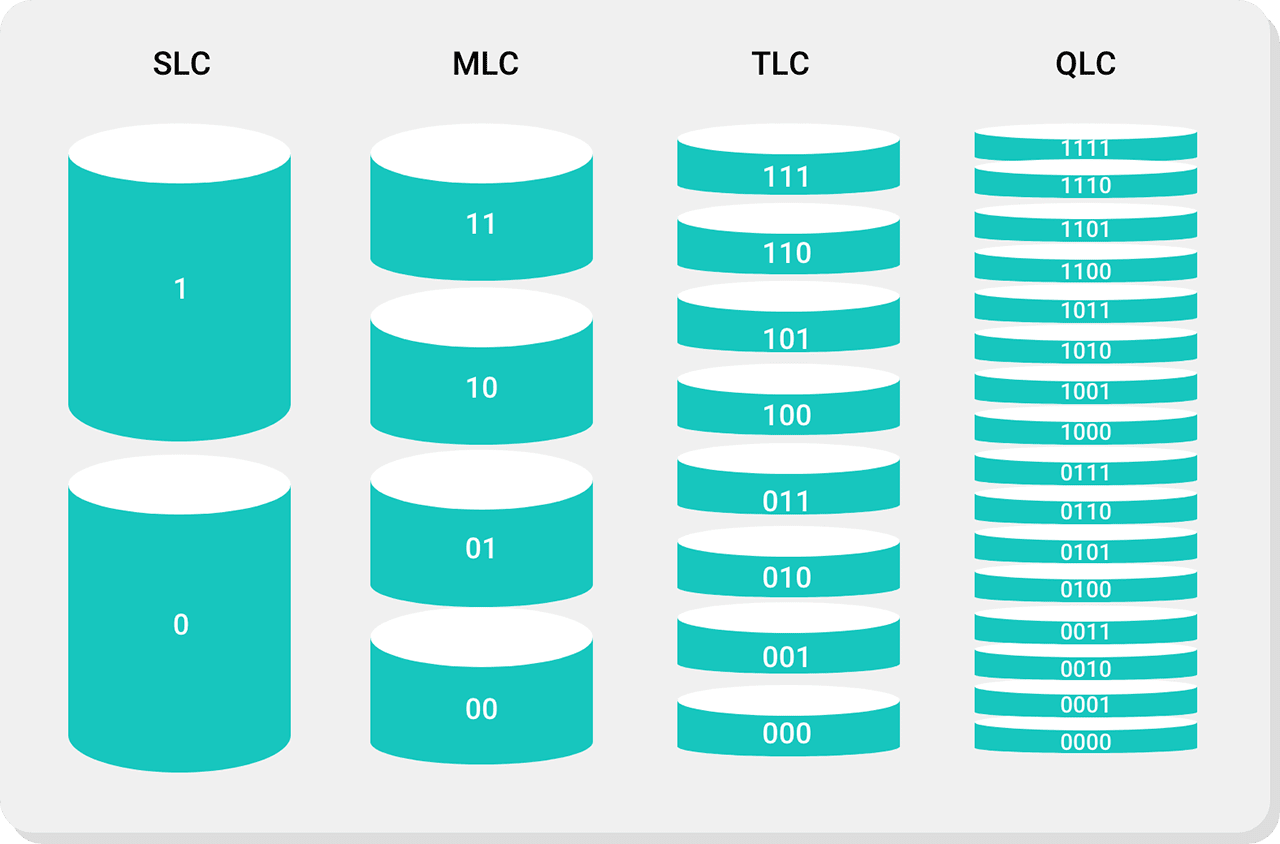
QLC έναντι TLC
Τα QLC και TLC είναι και τα δύο σημαντικά για την αποθήκευση δεδομένων.
Για τους OEM και άλλα ενδιαφερόμενα μέρη, η σωστή προσέγγιση εξαρτάται από τα δυνατά σημεία κάθε τεχνολογίας — και τα καλύτερα αποτελέσματα για τους χρήστες εξαρτώνται από τη γνώση του πώς συγκρίνονται το QLC και το TLC.

Υψηλότερες χωρητικότητες
Το QLC αυξάνει την πυκνότητα αποθήκευσης αποθηκεύοντας τέσσερα bit ανά κελί, προσφέροντας περισσότερο χώρο από τα τρία bit ανά κελί του TLC.

Σχέση κόστους-αποδοτικότητας
Το QLC παρέχει περισσότερη αποθήκευση ανά κελί σε σύγκριση με το TLC σε χαμηλότερο κόστος, καθιστώντας τις λύσεις υψηλής χωρητικότητας πιο προσβάσιμες.

Πλεονέκτημα εντατικής ανάγνωσης
Το QLC διαπρέπει σε εφαρμογές που απαιτούν μεγάλο όγκο ανάγνωσης, όπως η αναθεώρηση μεγάλων βιβλιοθηκών περιεχομένου και η διαχείριση απαιτητικών επαγγελματικών φόρτων εργασίας.

Ισορροπημένοι συμβιβασμοί
Η Western Digital Innovation συνέβαλε στην παροχή των πλεονεκτημάτων χωρητικότητας του QLC, ενώ παράλληλα διαχειρίζεται την παραδοσιακά χαμηλότερη αντοχή και απόδοσή του.
Ποιος μπορεί να επωφεληθεί από το QLC;
Εάν αποθηκεύετε δεδομένα, το QLC μπορεί να βοηθήσει — αλλά το QLC μπορεί να βοηθήσει συγκεκριμένα τους OEM. Οι OEM (κατασκευαστές αρχικού εξοπλισμού) εργάζονται σκληρά για να παρέχουν ικανές, οικονομικές συσκευές στους χρήστες τους, είτε αυτοί οι χρήστες διαχειρίζονται επαγγελματικές εφαρμογές είτε οργανώνουν το οικογενειακό τους περιεχόμενο.
Με την τεχνολογία QLC flash NAND, οι ΟΕΜ μπορούν να προσφέρουν ακόμα μεγαλύτερη χωρητικότητα στους χρήστες τους. Απλώς πρέπει να επενδύσουν σε μνήμη flash QLC που μπορεί να εξισορροπήσει την αυξημένη πυκνότητα bit με την κορυφαία απόδοση.
Γιατί είναι σημαντικό το QLC;
Το QLC μπορεί να αποθηκεύσει περισσότερα bit ανά κελί μνήμης σε σύγκριση με τα TLC, MLC ή SLC NAND flash. Αυτό σημαίνει ότι παρέχει μεγαλύτερη χωρητικότητα αποθήκευσης στην ίδια συνολική περιοχή σε σχέση με τα παλαιότερα κελιά, μειώνοντας το συνολικό κόστος ανά GB.
Καθώς οι χρήστες δημιουργούν περισσότερο περιεχόμενο, αποθηκεύουν περισσότερα δεδομένα και καταναλώνουν περισσότερες πληροφορίες, χρειαζόμαστε τρόπους για να ενισχύσουμε τη χωρητικότητα και να το κάνουμε αυτό οικονομικά προσιτό. Με το QLC, οι συσκευές αποθήκευσης όπως οι σκληροί δίσκοι στερεάς κατάστασης SSD μπορούν να βοηθήσουν στην αποθήκευση περισσότερων χωρίς να αυξάνεται το φυσικό τους μέγεθος, χάρη στη βελτιωμένη πυκνότητα bit.
Εξερευνήστε το QLC για OEM
Οι κατασκευαστές αρχικού εξοπλισμού (OEM) αναμένουν να τροφοδοτούν πάνω από το 50% των μονάδων σκληρών δίσκων στερεάς κατάστασης SSD των πελατών με QLC έως το 2026.1
Οι χρήστες δημιουργούν περισσότερο περιεχόμενο, κοινοποιούν περισσότερα μέσα και αποθηκεύουν περισσότερα δεδομένα. Για τους OEM που κατασκευάζουν συσκευές για καταναλωτές και επαγγελματίες χρήστες, το QLC μπορεί να συμβάλει στην παροχή υψηλότερων χωρητικοτήτων στο ίδιο αποτύπωμα με χαμηλότερο κόστος ανά GB.
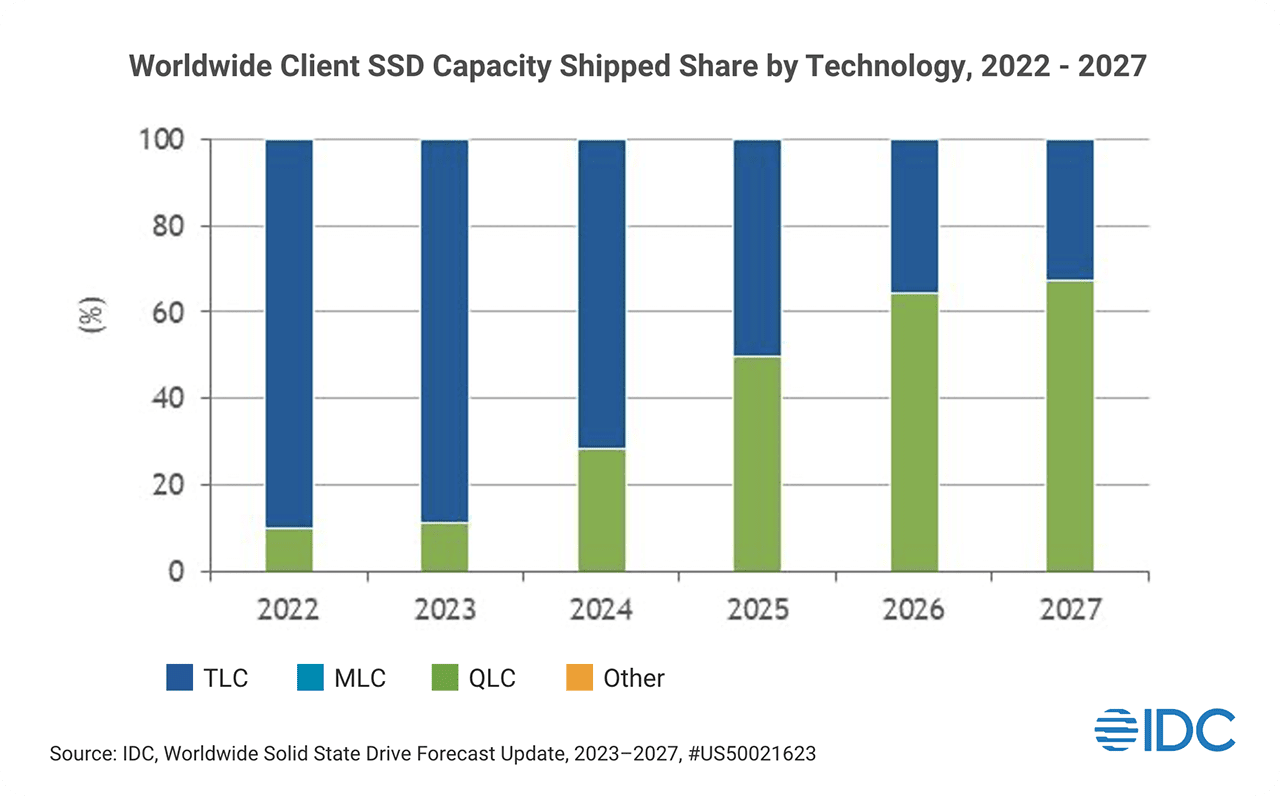
Οι OEM μπορούν να βελτιστοποιήσουν το QLC με το nCache 4.0 της Western Digital.
Περισσότερα bit και υψηλότεροι ρυθμοί δεδομένων απαιτούν πιο περίπλοκη αρχιτεκτονική για τη βελτίωση της διατήρησης, της απόδοσης και της αντοχής των δεδομένων. Η αποκλειστική μνήμη nCache της Western Digital μπορεί να βοηθήσει. Δείτε πώς:
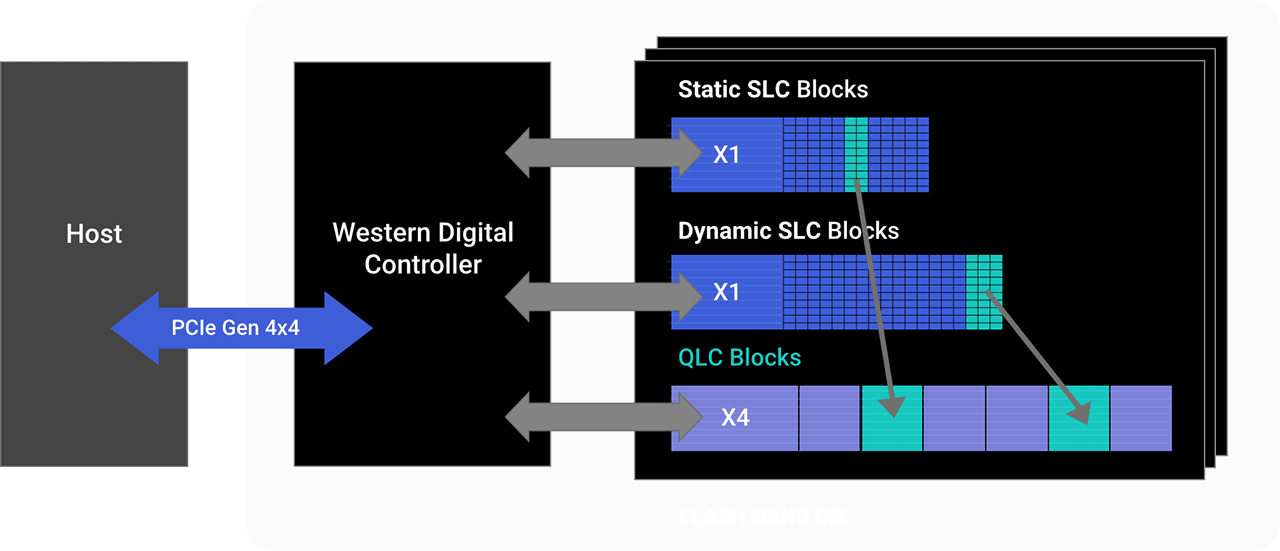
Η ταχύτητα συναντά τη χωρητικότητα
Η Western Digital nCache 4.0 διαθέτει δυναμική τεχνολογία SLC, η οποία εγγράφει δεδομένα σε υψηλές ταχύτητες σε μπλοκ SLC πριν τα αντιγράψει στο QLC κατά τη διάρκεια του χρόνου αδράνειας.
Έξυπνη προσωρινή αποθήκευση
Με την έξυπνη διαχείριση του τρόπου εγγραφής των δεδομένων στη μονάδα, η Western Digital nCache 4.0 συμβάλλει στην παράταση της διάρκειας ζωής των μονάδων σκληρών δίσκων στερεάς κατάστασης QLC SSD. Αυτό ελαχιστοποιεί τη φθορά στα κελιά μνήμης και βοηθά στη διατήρηση της ασφάλειας των δεδομένων για μεγαλύτερο χρονικό διάστημα.
Διαφορετικές περιπτώσεις χρήσης
Είτε δημιουργείτε περιεχόμενο είτε εργάζεστε στο επόμενο επαγγελματικό σας έργο, η μνήμη Western Digital nCache 4.0 παρέχει απόδοση υψηλής ταχύτητας με μεγάλες χωρητικότητες.
Οικονομικά αποδοτική χωρητικότητα
Η Western Digital nCache 4.0 σε συνδυασμό με το QLC μεταφράζεται σε πιο προσιτές μονάδες υψηλότερης χωρητικότητας, επιτρέποντας στους χρήστες να αποθηκεύουν περισσότερα χωρίς συμβιβασμούς στην απόδοση.
Ανακαλύψτε μονάδες σκληρών δίσκων στερεάς κατάστασης QLC SSD
Ερωτήσεις σχετικά με το QLC;
Επικοινωνήστε με ειδικό για να μάθετε περισσότερα σχετικά με το QLC για την ομάδα σας.
Δηλώσεις
1. Πηγή: IDC, Παγκόσμια Ενημέρωση Πρόβλεψης για Σκληρούς Δίσκους Στερεάς Κατάστασης, 2023-2027, #US50021623
2. Βάσει εσωτερικών ελέγχων. Western Digital PC SN5000S Gen 4.0 (BiCS6 QLC) έναντι Western Digital PC SN740 Gen 4.0 (BiCS5 TLC).
3. Με βάση τις ταχύτητες ανάγνωσης, εκτός εάν ορίζεται διαφορετικά. Ένα megabyte ανά δευτερόλεπτο (MB/s) = ένα εκατομμύριο byte ανά δευτερόλεπτο. 1 GB/s = ένα δισεκατομμύριο byte ανά δευτερόλεπτο. Με βάση τις εσωτερικές δοκιμές, η απόδοση θα ποικίλλει ανάλογα με τη βασική συσκευή, τις συνθήκες χρήσης, τη χωρητικότητα της μονάδας και άλλους παράγοντες.
4. Σύγκριση με βάση το μοντέλο Western Digital PC SN740 2TB.
Οι προδιαγραφές προϊόντος ενδέχεται να αλλάξουν χωρίς ειδοποίηση. Οι εικόνες που εμφανίζονται ενδέχεται να διαφέρουν από τα πραγματικά προϊόντα.
Η ονομασία Western Digital, ο σχεδιασμός της Western Digital, το λογότυπο της Western Digital και η ονομασία nCache είναι σήματα κατατεθέντα ή εμπορικά σήματα της Western Digital Corporation ή των θυγατρικών της στις Η.Π.Α. ή/και στις άλλες χώρες. Το σήμα NVMe αποτελεί σήμα κατατεθέν της NVM Express, Inc. Το PCIe® αποτελεί σήμα κατατεθέν της PCI-SIG. Το TCG Opal είναι εμπορικό σήμα της Trusted Computing Group. Όλα τα υπόλοιπα εμπορικά σήματα αποτελούν ιδιοκτησία των αντίστοιχων κατόχων τους.
